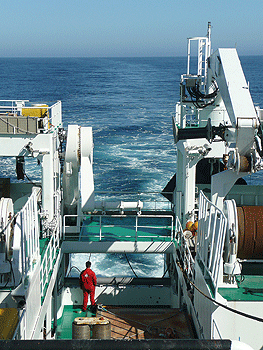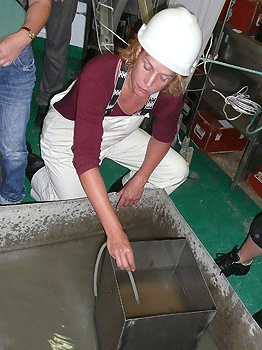Heading for the field
29.07.2008 During this wonderful day, the boat has made a couple of halts to carry through a CTD, a Boxcore- and a Multicore-test. The CTD gives the multibeam-echo-sounder information about salt contents, temperature, depth of the ocean and density .These factors are essential for the Multibeams ability to give an accurate 3-d picture of the seafloor.
Main content
It’s quiet on board. Occasionally the crew pops up to do their duties. The ship need maintenance and supervision day and night, nothing can be left to itself.
Mats continue with his monitoring of the seismic-penetration of the seabed, he use a so called “green” seismic, this shoot sonic signals which returns and gives an accurate record of the seafloor. The seismic is also able to give survey of the layers under the seafloor’s surface. Depending on the strength of the signals, the scientists are able to say what the layers nearly 100 meters under the seafloor consist of.
The results of the boxcore- and multicoretests have to be analyzed, and the biologists and biochemists get ready to do their job at the lab. The biologists use a top layer of 10 cm of the sediments when they are performing their analyses. The first task is therefore to cut these layers up in a half centimeter thin flake. Then they analyze it to find out what kind of microbiologic life forms exist there. This is new knowledge, but it is not expected to find a lot of bacterial lives in the sediments. They only expect to find bacteria in the upper layer, and de-escalation of life forms downwards. They also hope to find out what kind of gas these bacteria fix/breathe in. It’s known that bacteria fix/breathe both with carbon dioxide and methane gas as energy source, other also fix/breath with sulfate, nitrate and so on.
In another lab do we find the chemist Espen. One of his many tasks is to analyze the water taken up from 1000 m deep. He is trying to find out if there exist any volatile organic acids in the water as acetate or an acetic acid, with an instrument called ITP (IsoTachoPhoresis)

